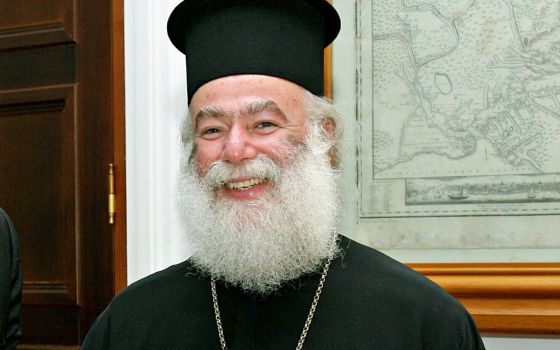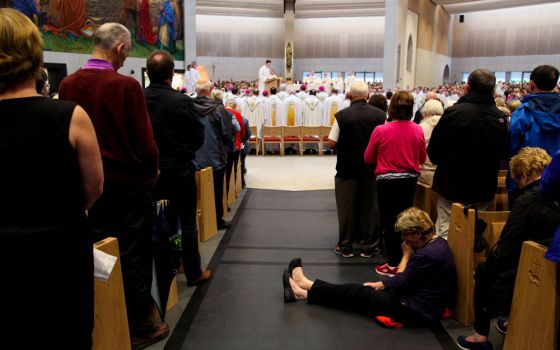The unordained "deaconess" idea is a train wreck waiting to happen. First floated by retired German Cardinal Walter Kasper, it's been picked up by nearly retired Archbishop Robert Zollitsch of Freiburg, chair of the German Bishops' Conference. Was there trouble in the transporter room when they came from their planet?
Translation from their extraterrestrial talk: Women can do the work and have a title, but they cannot be sacramentally ordained. For no earthly reason.
The question of returning women to the ordained diaconate -- a historical reality supported by truckloads of evidence -- has bounced around for more than 40 years. Pope Paul VI asked the obvious question when the permanent diaconate arose in the early 1970s: What about women in the diaconate?
One answer came from Cipriano Vagaggini of the Camaldolese Benedictines, a member of the Vatican's International Theological Commission. His 15,000-word study concluded that "theologically, in virtue of the use of the Byzantine Church, it appears that women can receive diaconal ordination." Never an official Vatican document, "L'ordinazione delle diaconesse nella tradizione greca e bizantina" was published in the influential scholarly journal Orientalia Christiana Periodica in 1974.
Scholarly debate ensued. The great divide was unordained "deaconesses" versus women sacramentally ordained as deacons. The basic hysteria was (and is) that women ordained as deacons present a side entry for women into the priesthood. Of course, that is not true. Deacons are not mini-priests. Deacons are deacons.
Significant modern teaching argues against women in the priesthood. The bottom line is not likely to change; the church does not believe it has the authority to ordain women as priests.
So if you say a woman ordained as deacon can become a priest, you do not agree with church teaching. Is that what Kasper and Zollitsch believe?
The problem is that "O" word: ordination. But it shouldn't be. Up until the 12th century or so, both men and women were ordained as deacons. Liturgies, tombstones, council documents and papal letters attest to that fact. In previous centuries, as various languages developed, some of the women ordained as deacons had come to be called "deaconesses." Complicating matters, there were also unordained "deaconesses" about the land. For some, it was a job title; for some, it signified their marriage to a deacon. Coincidentally, the diaconate as a permanent order was dying out.
During the Middle Ages, as sacraments were defined, ordination increasingly meant priesthood (bishops were consecrated), with the diaconate a stop along the way. Since women were not destined to be priests and the priesthood had absorbed all the deacon's duties anyway, fewer and fewer women (and men) took up the diaconate as their permanent vocation.
However, the deacon is ordained "not to the priesthood, but to the ministry," and what the church has done before, the church can do again.
By the late 1990s, a short study by the Vatican's International Theological Commission agreed. But the ITC prefect, one Cardinal Joseph Ratzinger, refused to publish it. So the question of women as deacons went back to committee -- a new committee headed by one of Ratzinger's former graduate students -- to get it "right." By 2002, the study had grown from under 20 to more than 70 inconclusive pages: Women deacons of history are not the same as male deacons; the diaconate is distinct from priesthood and episcopacy; it is up to the "discernment" of the church to decide on ordaining women as deacons.
And so, the beat goes on. Lately, the few who support unordained "deaconesses" have unplugged the discarded "in persona Christi" argument from priesthood (the male priest represents the male Jesus) and spliced it onto the notion that women's sole icon is Mary.
Here's the deal. First, to say women cannot image Christ undermines the essential teaching that all persons (male and female) are made in the image and likeness of God. Second, that 2002 study document says deacons serve "in persona Christi servi" -- in the person of Christ, servant. Third, to say women are "unordainable" because the current law forbids it mixes apples and toothpaste: Law does not determine theology. (Canon 1024 -- only a baptized male is validly ordained -- reflects ordination to priesthood.)
So now, two German bishops are driving the idea of unordained "deaconesses" down the track, risking an horrific collision with the 600 million or so Catholic women who always thought they were made in the image and likeness of God. At least, the catechism tells them so.
[Phyllis Zagano is senior research associate-in-residence at Hofstra University and author of several books in Catholic studies. She will speak Sept. 20-21 at Wisdom House in Litchfield, Conn.; Oct. 13 at Thomas More Chapel of Yale University; and Oct. 23 at Boston College. Her recent books include Women & Catholicism (Palgrave-Macmillan), Women in Ministry: Emerging Questions about the Diaconate (Paulist Press) and Women Deacons: Past, Present, Future (with Gary Macy and William T. Ditewig, Paulist Press).]
Editor's note: We can send you an email alert every time Phyllis Zagano's column, "Just Catholic," is posted. Go to this page and follow directions: Email alert sign-up.


